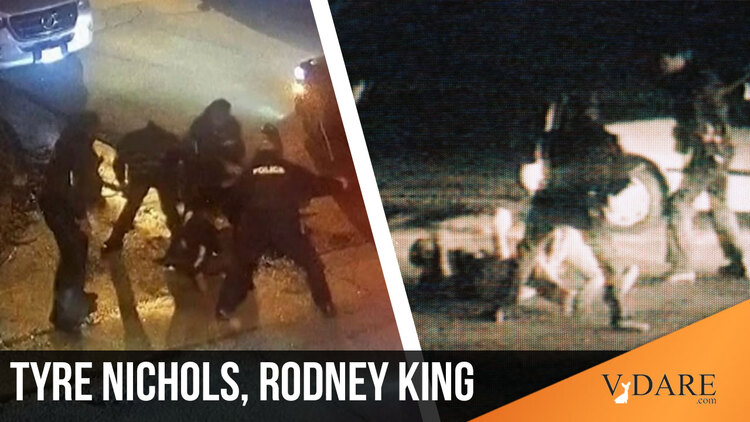


02/04/2023
A friend points out that the Memphis Five beating of Tyre Nichols contrasts sharply with the LAPD’s notorious beating of Rodney King. Rodney was a big strong man who kept getting up to fight the cops, who seem to have at least been trained in a process of what to do in such situations.
Here’s a good table of the process the L.A. cops went through trying to subdue King:
Level 1: Physical Presence
Normally, just the physical presence of police officers is enough to convince suspects to cooperate. … In the King case, however, the presence of four squad cars (with lights on and sirens blaring), a police helicopter overhead, and several officers with guns drawn and pointing at King failed to produce the desired level of cooperation.Level 2: Verbalization
When physical presence is not enough to ensure cooperation, LAPD officers were taught to issue verbal commands to suspects. The Holliday videotape indicates that King received at least fourteen commands to “get down.” Officers wanted King to lie in a prone position on his belly with his head down and hands behind his back. King did not comply with the commands.Level 3: Swarming
Confrontations usually can be ended with a group of officers swarming the suspect and bringing him to the ground. In the King case, Sergeant Koon ordered his officers to swarm the suspect. King succeeded, however, in repelling the attack.
The LAPD had recently abolished use of chokeholds for subduing obdurate suspects after a number of black male suspects had died.
Level 4: TASER (Tom A Swift Electric Rifle) Use
Tasing a suspect will usually knock a suspect to the ground, enabling him to be subdued and arrested. In the King case, Sgt. Koon zapped King with two Tasers (each zap carrying 50,000 volts). The TASER knocked King to his knees, but he was able to rise again and charge at one of the LAPD officers (Powell).Level 5: Use of PR 24 Metal Batons
The Holliday videotape shows LAPD officers repeatedly striking (by one count 56 swings, resulting in 31 hits) King with PR 24 metal batons. Officers are instructed to use the batons against the body mass of the suspect, then step back to evaluate whether the suspect has been sufficiently incapacitated to be arrested.
Eventually, that proved sufficient, so Level 6 was not reached.
Level 6: Use of Deadly Force
When none of the above options succeed in subduing a suspect (or for some reason are not available as options), LAPD policy authorized the use of deadly force–usually a gun–in felony cases where some imminent safety risk was presented by the suspect.
When jurors and judges had a chance to study the Rodney King videotape closely, they tended to come to feel only the last few blows on King were excessive. I can recall an interview with three jurors from the second it’s-not-double-jeopardy-if-everybody-wants-to-send-you-up trial saying the jurors voted to convict only on the last single blow as beyond a reasonable doubt unjustified by King’s actions. The 2nd trial judge thought the last 6 blows, out of over 50, were unjustified
From Wikipedia:
During the three-hour sentencing hearing, US District Judge John G. Davies accepted much of the defense version of the beating. He strongly criticized King, who, he said, provoked the officers’ initial actions. Davies said that only the final six or so baton blows by Powell were unlawful. The first 55 seconds of the videotaped portion of the incident, during which the vast majority of the blows were delivered, was within the law because the officers were attempting to subdue a suspect who was resisting efforts to take him into custody.
In contrast, a friend’s opinion of Memphis video is that it looks much more like a typical WorldStarHipHop video of five guys stomping one guy out behind the rap club.